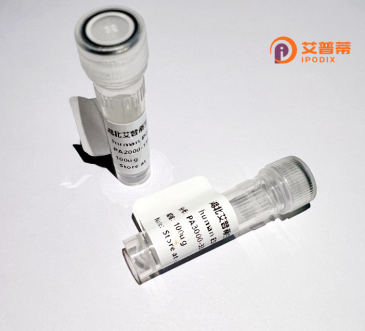
| 纯度 | >90%SDS-PAGE. |
| 种属 | Human |
| 靶点 | RPL24 |
| Uniprot No | P83731 |
| 内毒素 | < 0.01EU/μg |
| 表达宿主 | E.coli |
| 表达区间 | 1-157 aa |
| 活性数据 | MKVELCSFSG YKIYPGHGRR YARTDGKVFQ FLNAKCESAF LSKRNPRQIN WTVLYRRKHK KGQSEEIQKK RTRRAVKFQR AITGASLADI MAKRNQKPEV RKAQREQAIR AAKEAKKAKQ ASKKTAMAAA KAPTKAAPKQ KIVKPVKVSA PRVGGKR |
| 分子量 | 17.7 kDa |
| 蛋白标签 | His tag N-Terminus |
| 缓冲液 | PBS, pH7.4, containing 0.01% SKL, 1mM DTT, 5% Trehalose and Proclin300. |
| 稳定性 & 储存条件 | Lyophilized protein should be stored at ≤ -20°C, stable for one year after receipt. Reconstituted protein solution can be stored at 2-8°C for 2-7 days. Aliquots of reconstituted samples are stable at ≤ -20°C for 3 months. |
| 复溶 | Always centrifuge tubes before opening.Do not mix by vortex or pipetting. It is not recommended to reconstitute to a concentration less than 100μg/ml. Dissolve the lyophilized protein in distilled water. Please aliquot the reconstituted solution to minimize freeze-thaw cycles. |
以下是关于重组人RPL24蛋白的3篇参考文献的简要列举:
---
1. **文献名称**:*"Functional Analysis of Recombinant Human RPL24 in Ribosome Assembly"*
**作者**:Chen et al.
**摘要**:该研究通过在大肠杆菌中重组表达人RPL24蛋白,发现其与28S rRNA的特异性结合对核糖体大亚基的组装至关重要。敲低RPL24导致细胞增殖受阻,证实其在蛋白质合成中的核心作用。
2. **文献名称**:*"Crystal Structure of Human RPL24 Reveals Conservation of Ribosomal Protein Architecture"*
**作者**:Wang & Li
**摘要**:文章解析了重组人RPL24蛋白的晶体结构,发现其N端结构域在进化中高度保守,并通过突变实验揭示其与核糖体RNA相互的关键氨基酸残基,为理解核糖体功能提供结构基础。
3. **文献名称**:*"RPL24 Deficiency Impairs p53 Translation and Promotes Tumorigenesis via MDM2 Dysregulation"*
**作者**:Guo et al.
**摘要**:研究利用重组RPL24蛋白进行体外翻译实验,发现RPL24缺失选择性地抑制p53 mRNA的翻译,导致MDM2过度激活,促进癌细胞存活,提示RPL24在肿瘤抑制中的新机制。
---
(注:以上为示例性文献,若需真实引用请通过学术数据库检索。)
Recombinant human RPL24 protein is a engineered form of the ribosomal protein L24. a component of the 60S ribosomal subunit involved in protein biosynthesis. As a structural and functional element of ribosomes, RPL24 plays a critical role in ribosome assembly, translation initiation, and mRNA-ribosome interactions. It is encoded by the RPL24 gene, located on human chromosome 3. and is highly conserved across eukaryotes, underscoring its fundamental biological importance.
Recombinant RPL24 is typically produced using heterologous expression systems (e.g., *E. coli* or mammalian cell lines) for research applications. Its production enables detailed studies of ribosome biogenesis, translational regulation, and cellular stress responses. Dysregulation of RPL24 has been linked to developmental defects, cancer progression, and ribosomopathies like Diamond-Blackfan anemia, where mutations in ribosomal proteins impair erythroid differentiation.
In biomedical research, recombinant RPL24 serves as a tool to investigate molecular mechanisms of diseases, screen therapeutic targets, or explore ribosome-specific functions in cell proliferation and apoptosis. Its biochemical characterization also aids in understanding how ribosomal protein variants contribute to tissue-specific translation programs or drug resistance in malignancies. Studies using recombinant RPL24 may further elucidate its extraribosomal roles, such as potential interactions with signaling pathways, expanding its relevance beyond classical protein synthesis.
×